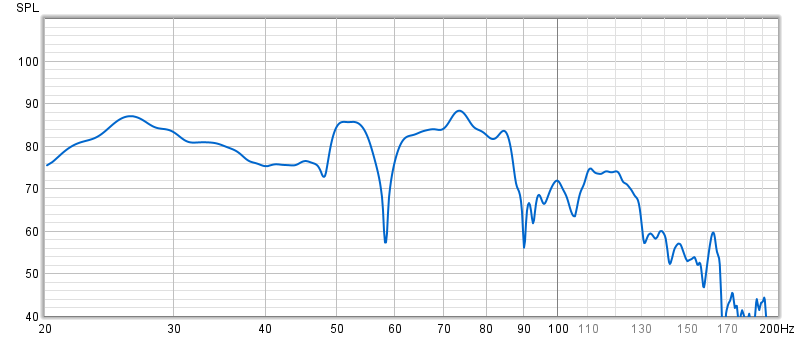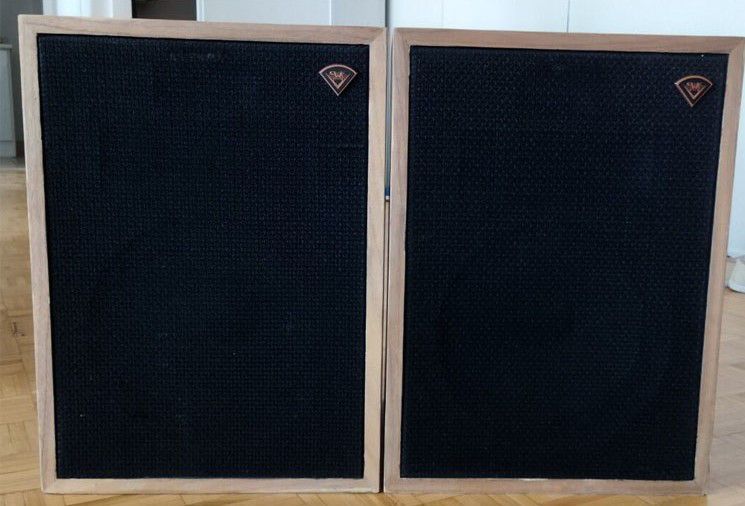
Dave MacKay
Regulars-
Posts
256 -
Joined
-
Last visited
Content Type
Forums
Events
Gallery
Everything posted by Dave MacKay
-
Forte 4 in Australian Walnut
Dave MacKay replied to Paducah Home Theater's topic in 2-Channel Home Audio
Is there more to these than the Australian Walnut veneer? $1000 seems to be quite a premium. -
That’s a neat idea. I’m curious to know what people would recommend, even in current products.
-
DSP on the cheap: suggestions from those who know
Dave MacKay replied to heresyForthe1sttime's topic in 2-Channel Home Audio
I have tried using DSP to address flaws in my listening room and to integrate subwoofers in my system for better bass. My experience may be ill-formed, but ... What I have found is that where and how much one can apply DSP is dependent on the equipment you have and how it is configured. If you don't have a pre-amp or receiver with pre-outs, your ability to tune your system with DSP will be pretty much confined to what your receiver manufacturer provides (e.g., via Audyssey, DIRAC, or YPAO) and integrating subwoofers. Not all systems (even within a the same brand) provide the same capabilities, allow much tailoring by the user, or show what processing is being applied. On the other hand, if you are bi-amping or tri-amping you have the flexibility to bypass the networks in your speakers and do whatever you wish. In my case, I don't have much ability to apply DSP to my mains. My Yamaha R-N803 receiver allows me to turn YPAO on or off and set distances and gain, but that's about it. It doesn't show what it's doing; it operates as a black box. That pretty much restricts my ability to apply DSP to the LFE (i.e., subwoofer) signal. I split the LFE signal and send it to two subwoofers. Although I started with the DSP capabilities provided by the plate amps (SPA250DSP) that power my subwoofers, I found those capabilities to be limited (no ability to set delay, for example) so that I ended up sending the LFE signal to a MiniDSP 2x4HD (which is far more capable) and feeding the the plate amps from it. I've used a measurement microphone (UMIK-1) and REW (Room EQ Wizard) software to assess what DSP to apply and to program the MiniDSP 2x4HD. However, I've not yet achieved results that I find pleasing. Others, such as @wuzzzer, have had much better --- indeed superb --- results. What you need to spend will depend on what you have, the problems you choose to address, and how far you want to go. You're likely looking at >US$400 to get started: the REW software is free (it's funded by donations from users), a UMIK-1 is about US$110, and a MiniDSP 2x4HD is about US$300. I'll look forward to what others with more knowledge and experience have to say. -
Connector on rear of 1983 Heresy?
Dave MacKay replied to Dave MacKay's topic in Technical/Restorations
That’s an interesting suggestion. My speakers only have remnants of the labels remaining. What is there is located towards the upper right-hand corner of the backs. The surviving text is the right way around which would indicate that the backs haven’t been rotated (unless the labels were removed and repositioned). Apart from the screws, there are no holes — or signs of holes that have been filled —- on the backs. That makes me think that what @jcn3 related about his ‘84 Heresy’s may also be applicable to my ‘83s. -
Connector on rear of 1983 Heresy?
Dave MacKay replied to Dave MacKay's topic in Technical/Restorations
Thanks. That fits with what I see on my speakers. There aren’t any screw holes visible at the top of the cabinet backs which supports the idea that the barrier strip would have been located where the cut out was made for the binding posts. -
I'll be restoring my new-to-me 1983 Heresy 1 speakers. My speakers have rectangular binding post cups to connect the speakers to an amp. Here's a photo (the cup is circled in red) of what I mean: The cut-outs for the binding post cups are fairly rough, which made me wonder if they might have been installed by a previous owner rather than at the factory. Would binding post cups have been original to the Heresy? Or would the Heresy have used a barrier block similar to this: If so, where on the back of the speaker would the barrier block have been located? (I assume it would be centred where the binding post cup is now).
-
Finish Suggestions for La Scala restoration?
Dave MacKay replied to aaronhirsch's topic in Technical/Restorations
I just picked up a pair of Heresy 1s on Friday. 😄 I’ll be refurbishing them when the warm weather returns. -
Finish Suggestions for La Scala restoration?
Dave MacKay replied to aaronhirsch's topic in Technical/Restorations
I can't speak to lacquers but I can share my experience. I veneered my La Scalas in Sapele and finished them with Rubio Monocoat "Clear". The Rubio finish is quite matte. Good luck with your project! -
I measured my subwoofers (2 x THTLP) the same way you did (UMIK-1, vertical orientation, ear level at MLP). However, my graph is nowhere near as nice as yours: I'll be paying careful attention to the YouTube video that @The Dude posted in the hope of improving my setup.
-
Seeking build info about 1983 Heresy speakers
Dave MacKay replied to Dave MacKay's topic in Ask the Historian
THANK-YOU!!! 😄 -
Impressive! Will you please share how you took this measurement? I have two THTLPs but haven’t gotten satisfactory measurements with them. I’m not satisfied with the MiniDSP settings I’ve gotten from REW when measuring at MLP. Usually, when measuring a speaker the microphone is positioned horizontally, 1 m from the speaker mouth. That technique doesn’t apply to subwoofers, especially to ones where the mouth is 6’ above the floor! Where did you position the microphone when measuring your THTLPs?
-
Seeking build info about 1983 Heresy speakers
Dave MacKay replied to Dave MacKay's topic in Ask the Historian
Thank-you for the information. Although the speakers look to be the same colour from the sides, from the tops one can see that one is quite a bit lighter than the other, as these photos show. Darker speaker Lighter speaker Both speakers side-by-side -
Yesterday I purchased a pair of 1983 Heresy speakers (serial numbers 154Y704 and 154Y710). I don't know why the serial numbers are close, but not consecutive. Unfortunately the seller wasn't able to tell me about them. Also, the labels on the back of the speakers are missing; only a few shreds remain. The speakers have: K-77M tweeters K-52H squawkers K-22E woofers E-2 networks I'm hoping that Klipsch's records might be able to answer a few questions for me: The finish on the speakers is quite degraded. What was the original finish on the speakers (e.g., oiled walnut)? There isn't any sign that there had been a gasket/foam seal on the removable rear panel. Should there be one? Where was the dealer located that Klipsch shipped the speakers to? Thank-you.
-
-
I used double-sided carpet tape. It has worked well.
-
Heritage Jubilee in a Small Room – Three Months in
Dave MacKay replied to MMurg's topic in 2-Channel Home Audio
Thank-you for posting what you did and --- especially --- how you did it. I'll try using your measurement and placement techniques. I've never been entirely satisfied with how my La Scalas are "dialled in". Perhaps your experience will be of help. -
The schematic diagram says "used till 2/83". Were there changes to the AA network after that date, or was that when Klipsch introduced the AL?
-
"The Little Jerry" is a small bar in Toronto that describes itself as a "sound bar" for audiophiles. The primary sound system has a pair of Khorns and a pair of La Scalas. Recommended.
-
This is very interesting (to me). Would you please explain what equipment is required to take such measurements and how one would go about it? If you're willing to do that, and if this is deemed inappropriate for this thread, please either send me a PM or start a new thread.
-
I'll have to check out DIYAudio. What other forums would welcome talk about Klipsch modifications?
-
'Should you tune your sound system FLAT'?
Dave MacKay replied to Schu's topic in Technical/Restorations
Although I try to get a flat response as a starting point, I then change my "house curve" to suit my taste. Starting with a flat curve (an oxymoron, I know) helps me to ensure I've addressed room modes that affect the sound. -
You might want to get REW (Room EQ Wizard, which is free software) and a calibrated microphone (such as a UMIK-1) so that you can take measurements to quantify the affect of different settngs and changes. REW is not an easy piece of software to master but it is marvellous. It helped me determine some of the challenges associated with my listening room and assess room treatments. Using it, I was able to ascertain that 1 subwoofer was never going to be adequate for my room. It also helped with subwoofer placement and configuring my DSP (a MiniDSP 2x4HD).
-
I matched an SVS SB 1000 Pro subwoofer to my La Scalas and was pretty pleased with it. It performed much better than the old Klipsch subwoofer I had been using, so +1 on the SVS. However, ultimately, I replaced the SVS subwoofer with a pair of THTLP subwoofers. If you're handy, a THT or THTLP can be built for about the price of an SVS 2000. The THTLP is excellent. Using two subs --- rather than one --- was the only way I could tame some room issues. If you go with >1 subwoofer, plan on getting a MiniDSP 2x4HD. It will make a world of difference.
-
D.O.S. Modules - rarely seen, but pretty keen.....
Dave MacKay replied to 13Hertz's topic in General Klipsch Info
I just refinished my La Scalas. There were no markings inside the feet on mine. Too bad; "Domes of Silence" is pretty neat. 🙂 -
Crossover Capacitors and Crossovers In General
Dave MacKay replied to Curious_George's topic in Technical/Restorations
Will you please post a summary of the answers to the questions you raised?













